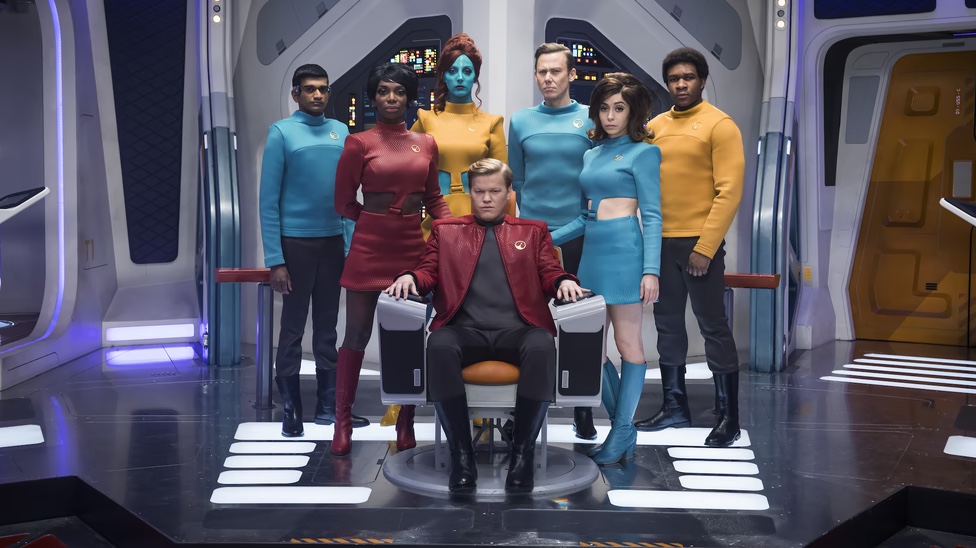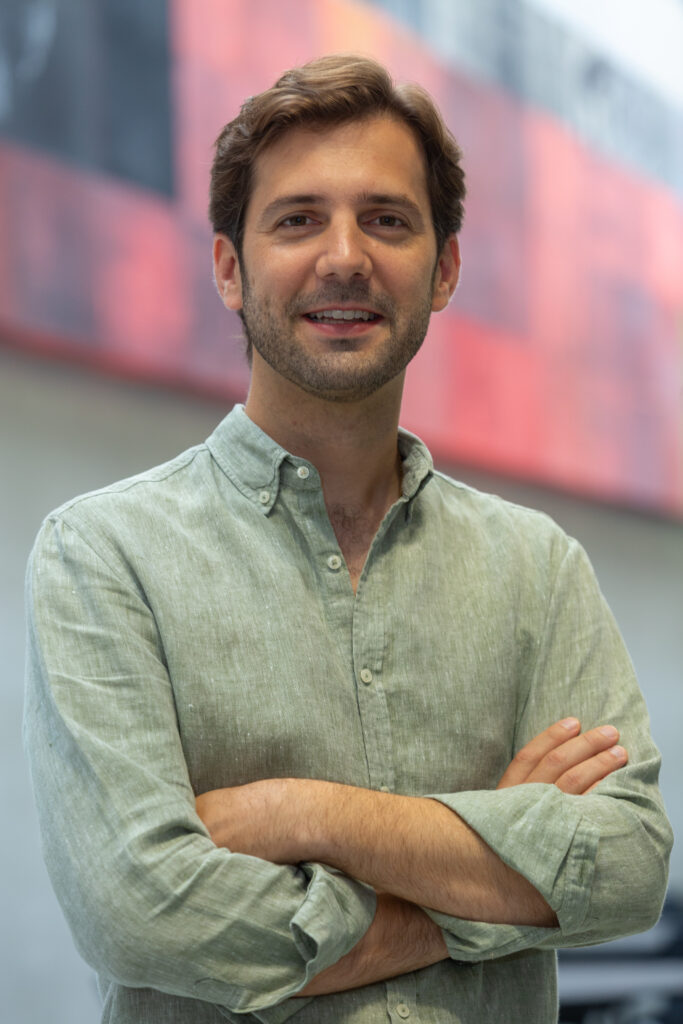By Alberto N. García and Pablo Castrillo Maortua
In February 2011, the British Prime Minister was suddenly awakened in the middle of the night. His cabinet urged him to watch a ransom video: The Princess had been abducted and she would only be released on the condition that he, the head of the Government, had sexual intercourse on national television… with a pig. Such a sinister and, of course, fictional premise can be considered the starting point for the renaissance of the TV anthology, a format that had previously been submerged under the tidal wave of serials and series during the “Third Golden Age” of television. Twelve years later, after a creative break (admittedly influenced by the dystopian detour imposed by the Covid-19 pandemic) and a change of production house, Black Mirror has returned to our metaphorically cracked screens with a sixth season. In a recent interview, creator Charlie Brooker remarked that this “should be a series that can’t be easily defined” and that the five new episodes, while “tonally Black Mirror through-and-through,” are meant to “stretch the parameters” of storytelling within the show. With undefined boundaries and elastic rules, the curious viewer may wonder—perhaps for the umpteenth time—what exactly is the TV anthology and what glues its episodes together. This is the main course of our upcoming article for NRFTS, of which we would like to offer a tasty side-dish.
The anthology format differs from series and serials in that its seasons consist of packages of episodes that are not connected by a narrative throughline, but instead feature a different plot, cast, and story world in each installment. This lack of narrative accumulation allows audiences to explore alternative continuities. If the story won’t force us to stick to a chronological and causal order, what is the point of seriality at all? Anthologies differ in their response to this question. Some are defined by theme or genre, while others adhere to spatial conditions (Room 104) or calendar dates (Into the Dark). Black Mirror is the quintessential example, not only for its popularity, but also for its straightforward proposition: while the episodes may be very different in style and plot, all of them develop a conceptual premise that has to do with the dangers of technology. The same can be said of Easy, which explores the quandaries of romantic intimacy; Lore, which focuses on the mechanics of myth-making; Love, Death and Robots, which offers variations of the classic sci-fi trope of robot rebellion; or the remake of The Twilight Zone, which delves into paranoia and implicit political commentary.
Now that the ‘streaming wars’ have been exposed as more of a Titanic-like full-steam charge into the iceberg of unprofitability—and that, consequently, the overall output of television shows is likely to slow down somewhat—it is important to consider industry context as a relevant factor to explain the brief, sharp upsurge of TV anthologies in the last decade. During the period known as ‘peak TV’—or ‘series craze,’ take your pick—the worldwide success of seriality also brought about a certain fatigue in the audience. Many viewers felt overwhelmed by the abundance of shows on display across their home screens, if not anguished by the impossibility of keeping up with the latest high-profile release. As this audience malady spread, the anthology format revealed itself as a clever way to suck in tired spectators. Because anthologies do not require a sustained viewing and because they allow ample room for experimentation, they were perceived as a promising hook for the interest of the audience… and for the branding of channels and streaming services. (Indeed, although the format began its latest popular cycle on the British Channel 4, it has been widely used by the content-avid streamers.) The type of casual consumption encouraged by anthologies fits into the ethos that the streaming consumers are used to, where one decides the viewing pace. Simply put, watching an episode of Black Mirror does not coerce you into forsaking sleep hours to finish a multi-part story. Thus, as Room 104 creator Mark Duplass put it, viewers may have come to see anthologies as “the Tinder of television”: “You pop in, you watch one episode… and you do not even have to come back.”

At the same time, the concomitant success of neighboring formats calls for differentiation between the TV anthology and the limited series. The latter includes likewise resounding successes such as Fargo, True Detective, and American Horror Story. These shows combine features of the TV anthology with traditional seriality, offering an independent story in each season, which is then rebooted with a different premise, cast, and setting. The essential difference, therefore, between the limited series and the TV anthology is that while the latter has absolutely no narrative continuity between episodes, the former presents a serialized story for a whole season, and thus its narrative reset occurs not after each episode but after a full season has ended.
Back to the streaming-era tidal wave of seriality, the year 2015 marked the turning point for the anthology. In that year, Black Mirror’s critical and popular acclaim led Netflix to acquire the show and continue its production exclusively for its subscribers from the third season onwards. Following the logic of commercial success, several programs —mainly from new streaming outlets— tried to emulate Black Mirror’s achievement. Thus, since 2017, there have been a myriad of popular TV anthologies: Netflix released Easy, Love, Death & Robots, and Criminal. Amazon Prime offered Lore, The Romanoffs, Philip K. Dick’s Electric Dreams, and Modern Love. Hulu went full horror with Into the Dark. HBO got into the game with Room 104 and Folklore, the latter from its Asia division. YouTube Originals made its first foray into the anthology format with Weird City. CBS All Access remade the classic The Twilight Zone. Apple TV+ tried a similar approach with its reboot of the famous Amazing Stories and, subsequently, took up a social-political banner with Little America. And even the short-form and short-lived mobile platform Quibi released its own horror anthology by the hand of executive producer Sam Raimi, 50 States of Fright.
One aspect frequently shared by these shows, surprisingly familiar yet always effective, is their recourse to last-scene surprise endings. Most of the episodes of Love, Death & Robots, for instance, pivot on final shots that leave the audience perplexed. “Suits” offers a glaring example: the episode tells of the brave resistance by a small community of farmers who, thanks to the eponymous mechanical suits, protect their land from an invading infestation of gigantic alien bugs. The farmers succeed in defending their borders and the narrative returns to normal: the characters enjoy a beer in their front porch while reflecting on the almost tragic events. Then, the big twist of the episode comes. The camera pans out and the audience realize that the humans are the real invaders, terraforming the native species’ planet along several force-field colonies. This type of twisted ending is productive not only for its amusement value but also for its cognitive payload. The last-minute turn invites viewers to re-read the narrative critically. Think likewise of “Pizza Boy” in Room 104 and “White Bear” in Black Mirror… Right?
In his examination of the original The Twilight Zone—easily the historical summit of the TV anthology—Carl Plantinga refers to these endings as “frame shifters”, because they “dramatically and decisively alter the spectator’s frame of reference. This isn’t a gradual process, which is why the element of surprise is central” (2009: 51). The aesthetic pleasure, therefore, derives at least in part from the suddenness of the shift. But not only that: the cognitive shock empowers viewers to make the most of their narrative experience. In the author’s own words, “the shift in framework results not only in pleasurable emotions such as surprise, fascination, and exhilaration, but also in vigorous critical thinking” (55). Let’s briefly unpack this. As psychologists will tell you, the mechanism of surprise is designed “to interrupt ongoing action and orient people to a possibly significant event” (Silvia, 2008: 49). The plot twists that characterize many TV anthology episodes work on a sensory and narrative incongruity that compels the audience to make new sense of the story. Writing about cliffhangers (not quite “frame shifters,” but an analogous device, to a degree), Luke Terlaak Poot points out how “the surprise ending has value insofar as it resolves tensions and instabilities and ‘opens up dimensions of the narrative that have largely been hidden until that point’” (2016: 63). Surprise, then, can act as an aesthetic intensifier because, in a way, it short-circuits our comprehension of the course of the events, turning them violently into a new direction. The spectator digs deep into his short-term memory of the narrative, searching for those hidden dimensions of the story that were already there but waiting to be lit up by the psycho-affective discharge of the twist. This kind of ending, when well crafted, will often make the audience’s emotional and cognitive engagement with the narrative deeper and, therefore, more pleasurable.
Naturally, there are many more aesthetic and narrative qualities of the TV anthology that are worth exploring. In our forthcoming article, “E Pluribus Unum: Toward a Poetics of the TV Anthology”, we strive to find the source of poetic unity that grants cohesion to the multifarious episodes bound together in this type of shows. In the absence of narrative accumulation, we spar with the concepts of thematic continuity (VanArendonk, 2019), operational seriality (Mittell, 2018), and temporal prolongation (Nannicelli, 2016) to shed light on the poetic peculiarity of the format. In this sense, there are several anthological markers—paratextual, authorial and generic—which underscore the importance of the episode as a narrative unit, inviting audiences to evaluate individual episodes as opposed to whole seasons. Yet at the same time, one episode of an anthology would necessarily offer an incomplete aesthetic and cognitive experience without the common themes, operational devices, and protracted narration of the whole season.
It remains to be seen whether the murky waters of a topsy-turvy streaming market will welcome more anthologies in the future. Prospects don’t seem too promising at the moment, but one can still hope that the sixth season of Black Mirror may, paradoxically, infuse some cheerfulness into this trailblazing format of television so that it may continue to bring juicy twists and turns for engaged viewers.
Alberto N. García and Pablo Castrillo Maortua’s article “E Pluribus Unum: Toward a Poetics of the TV Anthology” is in issue 22.2 of New Review of Film and Television Studies here.
Sign up for NRFTS alerts so you’ll know when future articles become available, and enjoy this related read:
Christopher Bartlett, ‘This I rebel against’: television advertising, Rod Serling’s The Twilight Zone, and a changing industry
References
Mittell, Jason. 2018. “Operational Seriality and the Operation of Seriality.” In The Edinburgh Companion to Contemporary Narrative Theories, eds. Zara Dinnen and Robyn R. Warhol, 227-238. Edinburgh: Edinburgh University Press.
Nannicelli, Ted. 2016. Appreciating the Art of Television: A Philosophical Perspective. New York: Routledge.
Plantinga, Carl. 2009. “Frame Shifters: Surprise Endings and Spectator Imagination in The Twilight Zone.” In Philosophy in the Twilight Zone, eds. Noël Carroll and Lester H. Hunt, 39-57. Chichester: John Wiley & Sons.
Poot, Luke Terlaak. 2016. “On Cliffhangers.” Narrative 24(1): 50-67.
Silvia, Paul J. 2008. “Interest—The Curious Emotion. Current Directions.” Psychological Science 17(1): 57-60.
VanArendonk, Kathryn. 2019. “Theorizing the Television Episode.” Narrative 27(1): 65-82.


